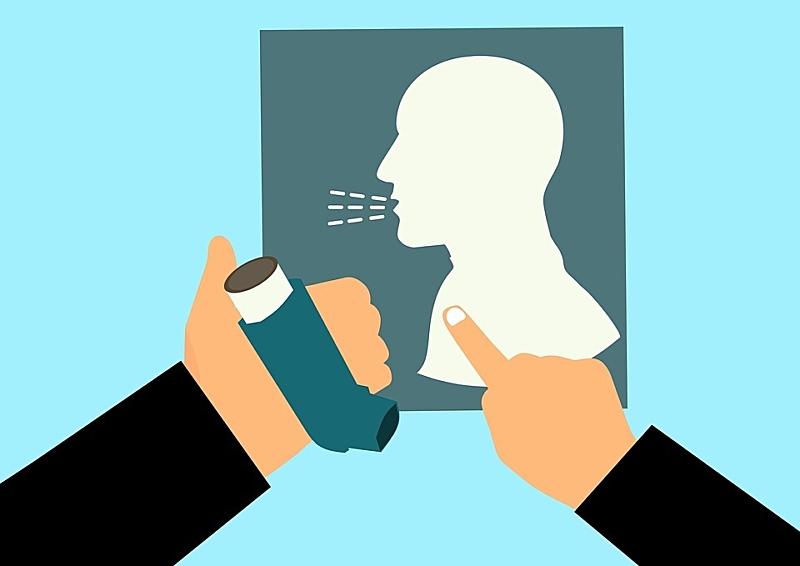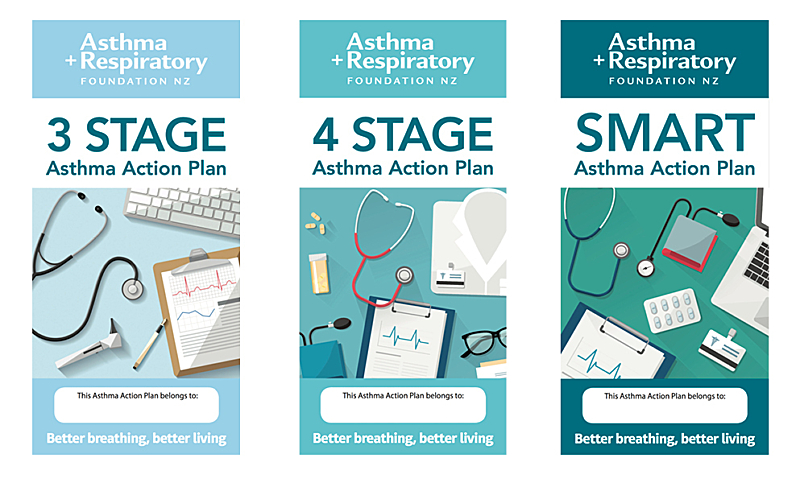Asthma is a common illness of the airways of the lungs. The airways become obstructed in response to stimuli, making it hard to get air in and out of the lungs, causing breathlessness and wheezing. People with asthma have sensitive airways which may be irritated by a trigger in the environment (such as pollen), by an illness, or by an emotion (such as anxiety). The irritation causes the airways to swell up and the muscles surrounding the airways to tighten so that it becomes difficult to breathe.
Asthma can be quite different between different people – the severity and the symptoms can vary.
In New Zealand one in seven children and one in eight adults need to take medicine for asthma.
Asthma is common in children, but about a third will grow out of it. Many children who wheeze will not go on to develop asthma at all. Asthma can persist for some people; this may require the use of inhalers to prevent the symptoms for an indefinite period.
Asthma is different for everyone. Although there are common triggers, different triggers affect different people. If a person is affected by an infective trigger (such as a cold), then winter will be when their asthma symptoms are worse for them. If the trigger is allergic, then springtime is the time when their asthma symptoms will occur.
There is no one answer to this question, although there are many theories. Asthma is more common in countries such as NZ with a high standard of living and a relative healthy population.
Statistics show that Māori, Pacific people and lower socioeconomic populations have a disproportionate burden of asthma, including high rates of hospital admissions.
There are many factors which potentially may increase asthma symptoms or attacks. These may include cold, damp housing, overcrowding, smoking or smoke exposure, a diet with lots of takeaways and not much fruit or vegetables, being obese, having difficulty getting to or affording health care services, not knowing how to use asthma medicines, or when and how to seek help.
Barriers to accessing health care may play a part in these poor statistics. These barriers include social, cultural, economic and geographic factors. Populations living in rural regions in New Zealand often find it difficult to access health care, resulting in inequities for both populations.
Māori and Pacific children with asthma suffer more severe symptoms, are hospitalised more frequently, and have more days off school as a result of their asthma; the data also shows that the ratio of reliever to preventer dispensing are highest in Māori and Pacific children. This means that Māori and Pacific children are more likely to depend on an asthma reliever and less likely to use inhaled corticosteroids (a preventer medication).
Studies, statistics and measures documenting the status of health for Māori and Pacific people confirm inequities. These populations experience systemic disparities in health outcomes, determinants of health, health system responsiveness and representation in the health sector workforce.
Asthma is different for everyone, with different triggers affecting different people. For some people this may mean that some areas of the country may be better to live in than other areas. However, it is not recommended that people with troublesome asthma move to another region in NZ in the hope that their asthma might improve.
These conditions can have a common allergic link. Eczema is often inherited and infants with parents who have allergies or asthma are at highest risk for development.
Atopic dermatitis is often the beginning of the atopic ‘march’: babies start out with eczema and perhaps food allergies then later asthma develops along with allergic rhinitis and hay fever. This results in an increase in the body’s allergic antibodies.
Some metered dose inhalers (MDIs) use ethanol (alcohol) to increase the solubility of the active ingredient; it has been used since the late 1990s. The amount of ethanol per actuation (puff) is tiny – less than 10 milligrams. There is considerably more ethanol in a ripe piece of fruit than in a dose from an inhaler. The amount of ethanol per dose is too small to have an effect on the body.
This level of ethanol is not dangerous to children.
Asthma medications themselves do not significantly affect breathalyser readings, but the alcohol used in some asthma inhalers may leave traces in the mouth for up to 3 minutes after a (MDI) inhaler is used.
Inhalers are not available to buy over the counter in New Zealand (from pharmacies without a doctor’s prescription) because high/excessive reliever inhaler use can make asthma more unstable and has been associated with deaths from asthma. The more you use relievers, the more unstable asthma can become. It is much better to treat the cause of the symptoms, rather than the symptoms themselves; uncontrolled asthma should be treated with inhaled corticosteroid or combination inhalers.

Inhaled corticosteroids (ICS) are the most important and useful medication in the management of asthma. They are the most widely used ‘preventer’ medicine and have been used extensively around the world for more than 20 years. There is an enormous body of research showing that they are effective and very safe even when taken in the long-term.
Inhaled steroids are generally safe for children with asthma. Side effects with these anti-inflammatory inhalers are minimal because doctors prescribe the lowest dose that will effectively control the child’s asthma.
Some side effects include local irritation in the mouth and throat causing hoarse voice, sore throat and oral thrush. These side effects can be avoided by using a spacer and rinsing the mouth or cleaning the teeth after use. Side effects affecting the rest of the body are uncommon but can include minor growth suppression in children.
It is important to remember that the risk of poorly treated asthma is far greater than the risk of serious side effects from inhaled steroids. Parents who are concerned about possible side effects from this medication should discuss this with their doctor
Swimming was recommended in the past as a good form of exercise for people with asthma as it was thought that breathing warm/moist air, rather than cold/dry air, might reduce the risk of exercise-induced bronchoconstriction and encourage good breathing practices. However, some people may find that the chlorine used in swimming pools may act as a trigger for their asthma. Each person’s asthma is individual to them and everyone reacts differently to different triggers. It is a good idea to avoid chlorine-based swimming pools if you are asthmatic.
E-cigarettes may sometimes work as part of a smoking cessation programme and may assist some people to quit smoking. However, there are many alternative quitting aids which have passed stringent regulatory processes that can also assist a person to quit. To-date, there are no long-term, robust clinical studies to show that e-cigarette use is not associated with any long-term harms, although harm from e-cigarette use is highly likely to be less than continuing to smoke. It would be very unwise for a non-smoking person who has asthma to start vaping. For a person who smokes and has asthma, the best thing to do is to quit smoking and to seek support from your health professional or from the Quitline (0800 778 778) to do so.

The Government has set a long-term goal of reducing smoking prevalence and tobacco availability to minimal levels, thereby making New Zealand essentially a SmokeFree nation by 2025. Current figures for the proportion of people smoking in New Zealand suggest that much more action is required in order to achieve the Smokefree Aotearoa by 2025, particularly for Māori and Pacific peoples.
Bronchiectasis is a chronic lung disease associated recurrent chest infections. It is very common in Pacific peoples and Māori and can be recognised by a wet cough for more than one month. They may have repeated infections requiring antibiotics.
If you think that you or your child may have bronchiectasis, discuss this with your GP.
In people with bronchiectasis it is important that they have sputum cultures when unwell, and they often need courses of antibiotics when they experience chest infections, recognised by an increase in the amount and discolour of their sputum, and fever.
Spacers should always be used with MDIs as it makes it easier for inhaled medication to reach the lungs and means less gets deposited in the mouth and throat. Spacers also improve coordination between delivering the medication from the inhaler - and breathing it in.
There are different types of asthma inhalers which contain different medication. Some provide fast relief and others are used for long-acting prevention of asthma symptoms. Asthma inhalers also have different mechanisms; some you are required to pump, and others are breath activated. It is important to match the right device to the person.
Asthma is a complex disease with multiple genetic and environmental risk factors. Some genes may have a protective effect while others increase the risk of asthma, with each gene having its own tendency to be influenced by the environment.
The risk of asthma in children with one affected parent is around 25%, whereas the risk if both parents are affected is around 50%. Research also shows that maternal asthma increases the offspring disease risk to a greater extent than paternal disease.
No. But there is the opportunity to practice personalised medicine now in patients with asthma. This requires identifying whether, in addition to asthma, patients might have overlapping conditions that present like someone with asthma, other disorders that might contribute to poor respiratory health, environmental or lifestyle factors that might be making asthma worse, or behavioural factors like poor inhaler technique or poor compliance which might be contributing to poor asthma control.
Currently there is no cure for asthma. It is a long-term disease that requires on-going treatment. The goal of asthma treatment is to control the disease and prevent chronic symptoms.
Research continues into a cure for this condition.
Yes, and making sure you do not smoke is the most important thing you can do to keep your baby healthy.
Monoclonal antibodies are laboratory-produced antibodies designed to recognise and bind to specific receptors found on the surface of cells. They are derived from natural antibodies made by the body’s immunological defence system that recognise and fight foreign invaders (such as bacteria and viruses). Monoclonal antibodies were first introduced in 1975 and have gone on to transform some areas of health care.
The cost of research, development and manufacture of these medications contributes to the high cost of monoclonal antibody treatments.
This is the ‘hygiene hypothesis’. There is some evidence that cleanliness has a negative effect on the prevalence of asthma (increases prevalence). The hygiene hypothesis proposes that childhood exposure to germs and certain infections helps the immune system develop. This teaches the body to differentiate harmful substances from the harmless substances that often trigger asthma. In theory, exposure to certain germs teaches the immune system not to over-react. It seems that as standards of living rise, so does the prevalence of asthma.

Some schools are reluctant to let children carry their reliever inhaler with them while in school and prefer to have all medications stored either in the classroom or in the sick bay. If this is the case, then parents/caregivers should work closely with the school explaining when their child may require their reliever medication. Parents/caregivers should prepare/coach their child to know how to ask for help to manage their asthma.
Some children who carry their own reliever inhaler may overuse it; this may have a negative effect on their asthma exacerbations and health outcomes.
Asthma can be hard to diagnose. Doctors must consider a number of things before a diagnosis can be made, including medical history and symptoms. Several childhood conditions can have symptoms similar to those caused by asthma.
Wheezing is common in young children. Many young children who wheeze will not go on to develop asthma.
A trigger is something that can make asthma worse. The body’s immune system over-reacts to certain things which may cause an asthma flare-up. There are a number of things that can trigger asthma including environmental, emotional, allergic, and infective factors.
Triggers are different for everyone and often it is not just one trigger that sets-off an asthma attack, but a combination of several triggers around the same time. Knowing as much as you can about your asthma triggers is important, so that you can avoid or reduce your exposure to them.
Identifying your triggers is often trial and error so it is useful to keep a note of what you have been in contact with when you find that your symptoms are becoming worse. Allergy testing can be done to identify an immune response, ask your doctor about this.
There are no specific recommendations on whether it is safe or not, however some common sense principles would apply:
- if you have recently had an asthma flare up you should have a follow up visit including a lung function test and have been cleared by your GP or specialist to travel
- your doctor should ensure that your oxygen saturation is be normal at rest and on exertion (walking)
- you must take all your asthma medications on board, including prednisone and a spacer if you use an MDI (metered dose inhaler)
- it's important to check the conditions on your travel insurance.
Peak flow readings can be used as an indication that asthma symptoms are worsening and are used in adult self-management to indicate when to increase medication and when to seek help.
However children carrying out peak flow readings can be unreliable, so depends on the maturity of the child, as a low reading can simply be an error in technique. This is why symptom based rather than peak flow based action plans are used for children.
Levels of asthma control can be monitored by the doctor asking questions, taking the answers into consideration, and then tailoring the child’s treatment to gain control of their asthma symptoms.
One of the most useful aids to maintaining good asthma control is to work closely with your asthma team (doctor and nurse). Have a child action plan so that you know when your child is well controlled, what to do if their symptoms are getting worse and most importantly what to do in an emergency.
This depends on the stage of diagnosis. If newly diagnosed then it may require to be updated quite often. Once asthma is under control it probably wouldn't change very often but would need to be checked annually.

Follow the below links to access the ordering site and for instructions on how to place your order:
Go through to the ordering site
Still having trouble using the online ordering site? Email shopasthma@streamlineprint.co.nz and they will assist you with your order.
Visit the GenLess website here, or contact your local council to find out if they have any local initiatives.